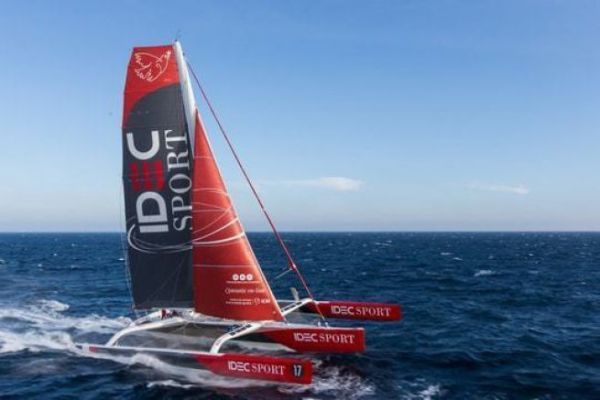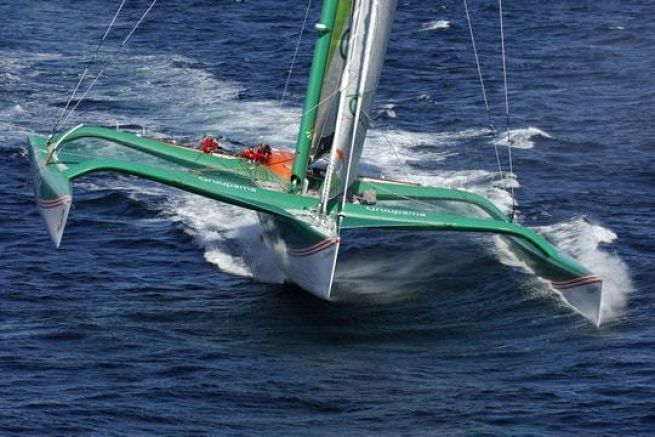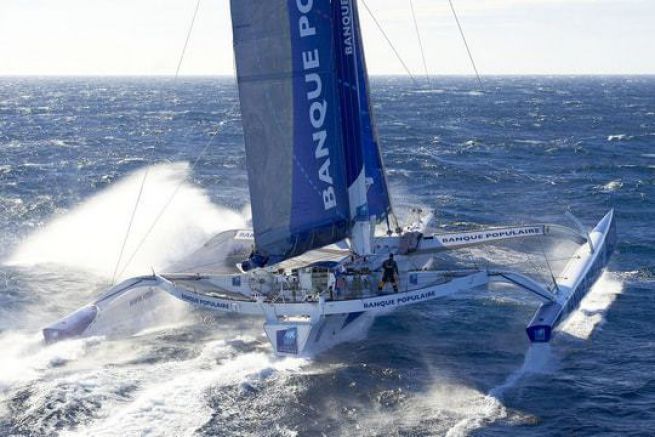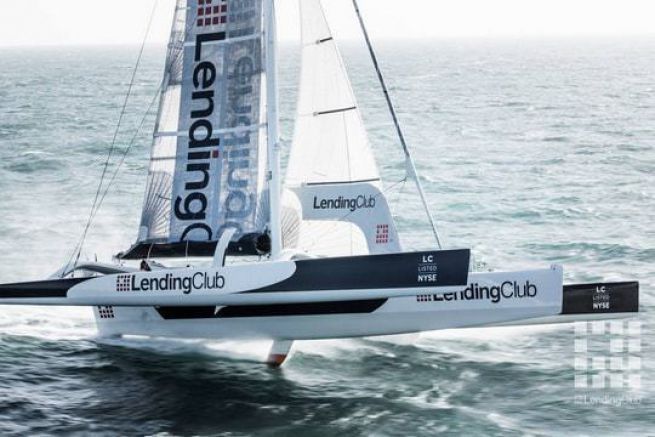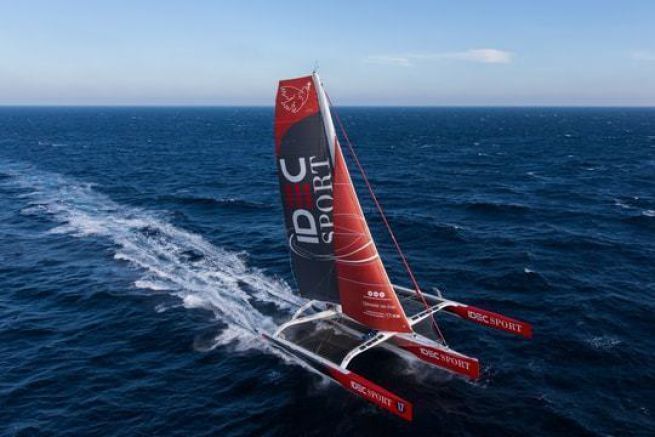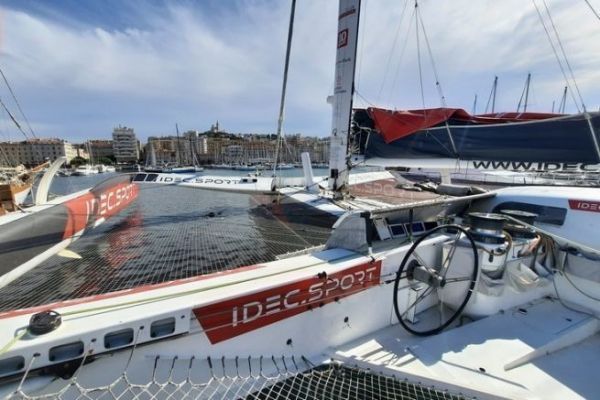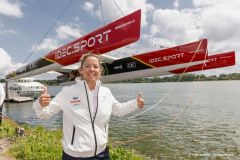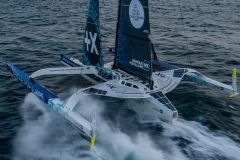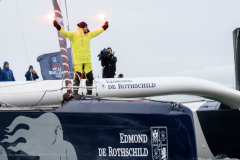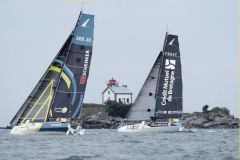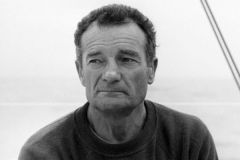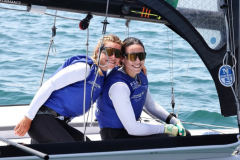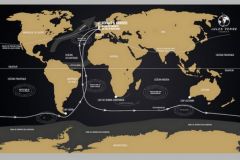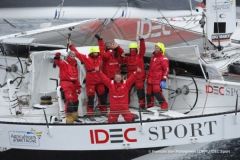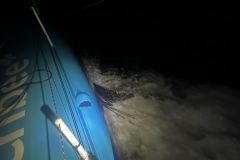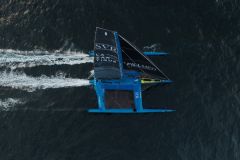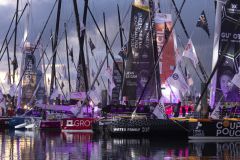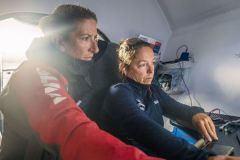Building the multihull for the Jules Verne Trophy
After a record-breaking summer 2015 under the name Lending Club 2, Francis Joyon has recovered his trimaran Idec Sport. Arriving in Vannes in early September 2015, the boat entered the yard at Multiplast. Even though the official handover was on September 15, Ryan Breymaier (the skipper of Lending Club 2) and Francis Joyon got a little bit of a head start.
Once in Vannes, the equipment and sails were dismantled and the Lending Club tickets were removed. The minor work following the use of the boat for the record campaign has been taken care of by Lending Club. Francis Joyon, for his part, has identified the improvements to be made in preparation for the Jules Verne Trophy. "The trimaran has been re-configured for a round-the-world race and the hostile seas of the Deep South.
Protection systems for the helmsman and the crew member who is at the winches watching the sheets have been installed. "I find that these posts are too exposed for the seas of the Deep South where it gets very wet. They need to be better protected for watches in those seas, with facilities to hold on and not be swept away by the waves." explains Francis Joyon.
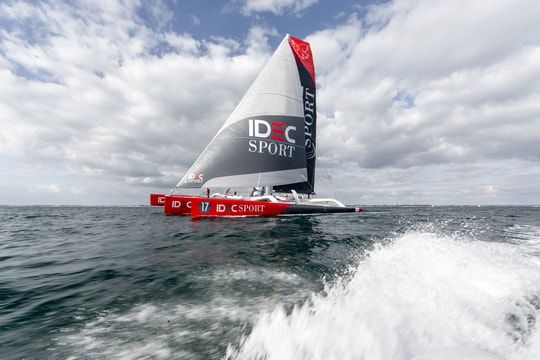
Credit: JM Liot/DPPI/IDEC
A watermaker and a system for drying boots and oilskins were installed, in order to carry less equipment and save weight. The small mast was adapted and two new sails were installed.
After three weeks of express refit at Multiplast (it was in this same yard that the trimaran Groupama 3 had been built), Idec-Sport âeuros all dressed in red - was launched on October 2, 2015. Put in the colors of Idec Sport, the boat has undergone a major refit, having accumulated 25,000 miles under the name Lending Club 2.
In addition to the work mentioned above, improvements were made such as a removable propeller shaft and a real navigation station inside. After the installation of the centerboard and the rudders, the boat went to Lorient, to be masted.
A word from the architect
"Spindrift 2 and IDEC SPORT will both enter the Jules Verne Trophy stand-by next autumn. The battle between the two crews will be exciting to follow. On the one hand, there will be an overpowered boat and on the other, a "moped" led by a reduced crew. The hypothesis of a victory for IDEC SPORT is quite possible. Light and maneuverable with its small rig, this boat is at ease in the transition zones. It will be able to do well in the descent and ascent of the Atlantic. IDEC SPORT, on the other hand, will be handicapped below 10 knots, but these are marginal conditions on the scale of a Jules Verne Trophy. In the Southern Ocean, if both boats encounter the same conditions, the differences will be minimal. IDEC SPORT is a safe boat on which we can shoot with complete confidence. That said, Spindrift 2 has been very well optimized and will be a formidable competitor.

Credit: JM Liot / DPPI / IDEC Sport
On paper, it will be faster than when it was in the colors of Banque Populaire V. Beating the 45 days of BP V is possible for IDEC SPORT and Spindrift 2. The bar is high, at a level where the weather is becoming preponderant. At the start of a Jules Verne Trophy, we have a fairly clear vision of the weather situation until we round the Cape of Good Hope and enter the Southern Ocean. After that, it's all unknown. The record is often decided on the way back up the Atlantic, so there is a certain amount of luck involved explains Xavier Guilbaud, architect at VPLP.
The Idec Sport trimaran in 10 essential points
1 âeuros The sails the trimaran has 5 sails : The mainsail, a gennaker which is used downwind and three flat sails of different sizes on the front called J1 J2 and J3. The headsails are mounted on furlers, which means that a roller allows them to be rolled around their stays. This is a wise precaution with a small crew, as it is easier than with sails on halyards that would have to be lowered and/or raised at each change.
2 âeuros The foils on each side float, port and starboard, there is a foil or "water wing." This profiled surface, whose immersion depth can be adjusted, provides dynamic lift. In other words, it allows the boat to be lifted off the ground at certain speeds This is the great revolution in sailing boats in recent years. The gains in performance are enormous compared to a boat without these load-bearing appendages.
3 âeuros The central drift : Multihulls do not have a keel. So to avoid "skidding" on the water and moving forward like a crab, IDEC SPORT - like all the big multihulls - is equipped with a long central daggerboard which ensures what the architects call the anti-drift plane.
4 âeuros The mast : IDEC SPORT is configured with its "small" mastâeuros¦ which is still its 33.50 mètres high. The big one was 6 meters higher, but it was necessary to take a reef (reduce the mainsail) as soon as 20 knots of wind. Triple advantage according to Francis Joyon: equal or even better performance, high mainsail, less risk of breakage, and above all two tons saved compared to the big boat.
5 âeuros The winch columns they are also known as "coffee grinders" and allow you to increase the effort (several speeds) and therefore to turn more easily the winches which are used to trim or ease the halyards and sheets. In addition, they can be used by two crew members, face to face, to combine efforts. The system is obviously disengageable. There is a column on each side of the boat.
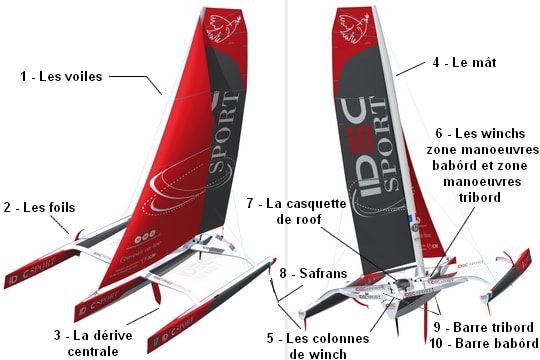
Credit: Mer & Media / JB Epron / IDEC
6 âeuros The winches for the port and starboard maneuvering areas on each side of the roof cap, there are two huge winches. They are mostly operated by the columns called "coffee mills" because of the enormous forces exerted on them (often several tons of traction). Just in front of them are the pianos or the ropes which are used for everything: hoisting or lowering the sails, reefing, raising, lowering or adjusting the appendages, etc. It should be noted that these four large winches can also be operated by a simple crank for the rare cases where the tension is lower. There is a fifth winch in the center of the cockpit.
7 âeuros The cap of roof it protects the sailor from the spray, allows the man on stand-by to rest and prevents the water from going down inside the central hull of the boat where the minimalist living quarters of the IDEC SPORT maxi trimaran are located.
8 âeuros The rudders these three appendages are the "shovels" that allow IDEC SPORT to be steered. There is a large central one, but also one on each side float. This prevents the boat from stalling when it starts to rise on its foils and is more efficient when one float is in direct contact with the water.
9 âeuros The starboard helm : On the previous IDEC trimarans, there was only one steering wheel, in the center. On this larger one, there is one on each side. On the right side of the boat, the starboard helm is the "steering wheel" used to steer the trimaran when it sails on starboard tack, when the wind comes from the right of the boat.
10 âeuros The side bar on the left side of the boat, the helm is used to steer the trimaran when it is sailing on a tack. That is, when the wind comes from the left of the boat. The helmsman thus faces the sail.
Victory in the Jules Verne Trophy
On December 16, 2016, Francis Joyon set off on the Jules Verne Trophy with a crew of 5 sailors: Clément Surtel, Gwénolé Gahinet , Bernard Stamm , Sébastien Audigane and Alex Pella . Slower at the start, they gained miles throughout the course, passing some of the major capes several days ahead. The last short-handed round-the-world race dates back to Bruno Peyron's record in 1993. Thursday, January 26, 2017 at 8:49 a.m. after 40 days, 23 hours, 30 minutes and 30 seconds, Francis Joyon and all his team win this beautiful victory . Although attempted several times by other crews since 2017, this record still belongs to him.
Victory in the Route du Rhum
A legend is born... While François Gabart on Macif is one of the big favorites in this 2018 Route du Rhum, it is Francis Joyon who is entering the legend. The two sailors were neck and neck throughout the crossing of the Atlantic, with François Gabart leading at the finish. But it was a breathtaking 6-hour finish around Guadeloupe that reshuffled the deck. Francis Joyon wins this 11th edition of the Route du Rhum with a race time of 7 days 14 hours 21 minutes and 47 seconds to complete the 3542 mile course at the speed average speed of 19.42 knots. He also set a new reference time by improving the race time of the 2014 edition (won by Loïck Peyron ) of 46 minutes 45 seconds. Aged 62, he finally enters the history of the race as it is his 7th participation.
An incredible gap âeuros the smallest in the history of the race since the 98 seconds of the first edition âeuros that makes this 40th anniversary of the race in the legendâeuros! A remake of the Birch/Malinovski duel in 1978âeuros!
The other records...
After the Route du Rhum, Francis Joyon continues to break records, including a campaign in Asia in 2019 . He comes back to this edition of the Route du Rhum 2022, because he likes adventure and maybe the weather will give him a nice surprise...

